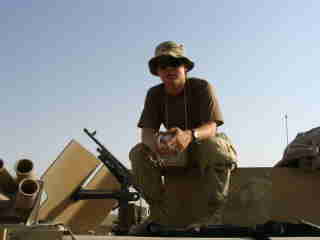I know that all of us troops, and all of the folks who like troops, are supposed to disapprove of John Murtha and automatically categorize anything he says about our involvement in Iraq as utter defeatist tripe.
But, as the southern people say, even a blind hog roots up an acorn from time to time. Murtha is calling for closer scrutiny of how the Commander's Emergency Response Program has been used.
"A fundamental review of CERP, its purpose, use and scope, is overdue," Murtha wrote in the July 15 letter to Defense Secretary Robert M. Gates. Murtha said he was disturbed by reports from Iraq suggesting commanders were in a "rush to spend" hundreds of millions of dollars by the end of the fiscal year.
War is not cheap. There's a reason it's known as a drain on "blood and treasure." But the CERP program is directed by a document we call "Money as a Weapons System," and flinging large piles of US taxpayers dollars at every problem, potential problem or confusing situation is every bit as silly as trying to resolve every kinetic problem with 155mm HE rounds.
In fact, it might be sillier, because I can't think of a single situation in which "success" was measured strictly in number of 155 rounds expended. And given the very real challenge of finding metrics to define success in a fluid counterinsurgency fight, the temptation to measure progress in terms of dollars spent or projects started can be mighty.
U.S. military officials say CERP has been invaluable in helping commanders get things done quickly, with little red tape. In recent years, they have used it to put insurgents on payroll, award micro-grants to business owners, compensate families of civilians killed in combat, and build schools and clinics.
Please understand that "very little red tape" is a relative statement. Our supported organization does pretty well with the CERP nomination and approval process, and it's a multi-step undertaking that even in the simplest circumstance (microgrants, if you're interested) moves in terms of weeks (and often, months), not days (qualifier: I have not handled a condolence payment on this tour, and I can't recall the timeframes when we did them last time around).
CERP has been valuable for building schools and clinics (and water treatment facilites and wells and roads and bridges and culverts and powerlines and hoophouses and corn silos). But have all of those been occupied, staffed and managed? Honestly, I don't know. I haven't been to all of them.
I do know that sometimes it's a challenge to get unit commanders to ask some of those harder questions when there's a pot of money that needs to be used by the end of the fiscal year/deployment/quarter and which battalion spends more of it is one of the few ways to measure who's done "more" during a given period of time.
If money is to be used a weapons system, it's imperative that we study its employment with the same diligence we apply to the use of armor in an urban fight, the employment of helicopter gunships in support of amphibious operations or the utility of gun trucks in base defense. It would be a valuable exercise, if for no other reason than that our experiences with money on the battlefield in Iraq may, if analyzed dispassionately and rigorously, enable us to leverage it to preserve the lives of our warriors in Afghanistan and future conflicts.

|